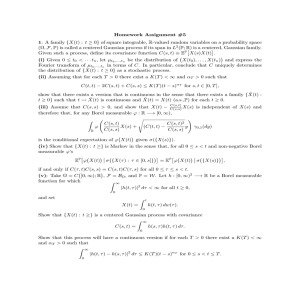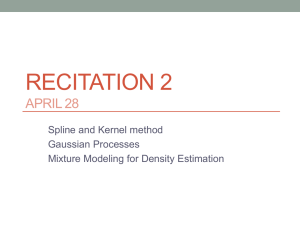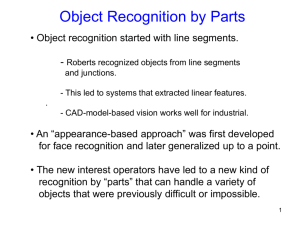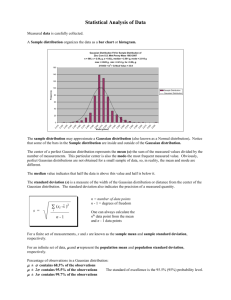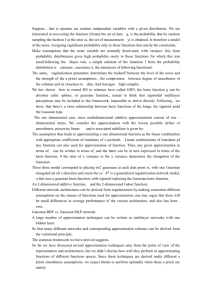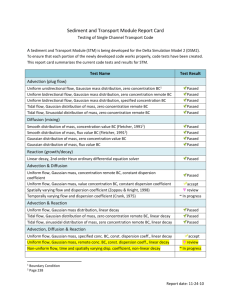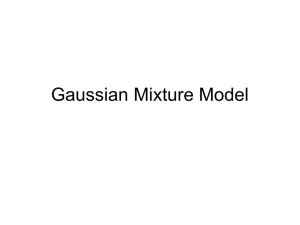Gaussian process regression
advertisement
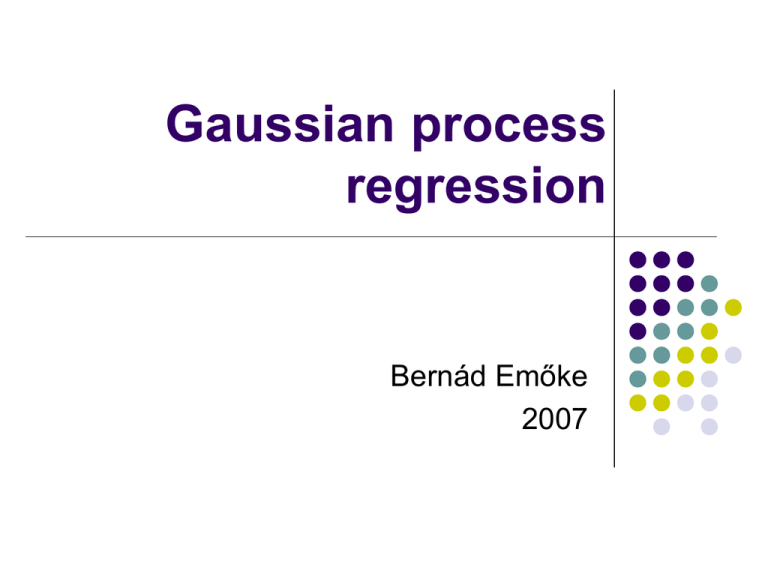
Gaussian process
regression
Bernád Emőke
2007
Gaussian processes
Definition A Gaussian Process is a collection
of random variables, any finite number of which
have (consistent) joint Gaussian distributions.
A Gaussian process is fully specified by its mean
function m(x) and covariance function k(x,x’).
f ~ GP(m,k)
Generalization from
distribution to process
Consider the Gaussian process given by:
f ~ GP(m,k),
1 2 and
k ( x, x' ) e
m( x ) x
4
( x x ') 2
2
We can draw samples from the function f (vector x).
1 2
( xi ) xi
4
( xi , x j ) e
( xi x j ) 2
2
, i,j = 1,..,n
The algorithm
…
xs = (-5:0.2:5)’;
ns = size(xs,1); keps = 1e-9;
% the mean function
m = inline(‘0.25*x.^2’);
% the covariance function
K = inline(’exp(-0.5*(repmat(p’’,size(q))-repmat(q,size(p’’))).^2)’);
% the distribution function
fs = m(xs) + chol(K(xs,xs)+keps*eye(ns))’*randn(ns,1);
plot(xs,fs,’.’)
…
The result
The dots are the values generated with algorithm, the two other
curves have (less correctly) been drawn by connecting sampled
points.
Posterior Gaussian Process
The GP will be used as a prior for Bayesian inference.
The primary goals computing the posterior is that it can be used to
make predictions for unseen test cases.
This is useful if we have enough prior information about a dataset at
hand to confidently specify prior mean and covariance functions.
Notations:
f : function values of training cases (x)
f* : function values of the test set (x’)
m( xi ) : training means (m(x))
* : test means
∑ : covariance (k(x,x’))
∑* : training set covariance
∑** : training-test set covariance
Posterior Gaussian Process
The formula for conditioning a joint Gaussian distribution is:
The conditional distribution:
f * | f ~ N ( * *T 1 f , ** *T 1* )
This is the posterior distribution for a specific set of test cases. It is
easy to verify that the corresponding posterior process
F | D ~ GP(mD , kD ) mD ( x) m( x) ( X , x)T 1 ( f m)
kD ( x, x' ) k ( x, x' ) ( X , x)T 1( X , x' )
Where ∑(X,x) is a vector of covariances between every training
case and x.
Gaussian noise in the training
outputs
Every f(x) has a extra covariance with itself only, with a
magnitude equal to the noise variance:
y ( x) f ( x) ,
~ N (0, n2 )
f ~ GP(m, k )
y ~ GP(m, k n2 ii' )
,
20 training data
GP posterior
noise level 0,7
Training a Gaussian Process
The mean and covariance functions are parameterized in terms of
hyperparameters.
For example:
f ~ GP(m,k),
m( x) ax2 bx c
k ( x, x' ) y2 e
( x x ') 2
2l 2
n2 ii'
{a, b, c, y , n , l}
The hyperparameters:
The log marginal likelihood:
1
1
n
T
L log p( y | x, ) log | | y 1 y log( 2 )
2
2
2
Optimizing the marginal
likelihood
Calculating the partial derivatives:
L
T
1 m
( y )
m
m
L 1
1
1
T
1
trace(
) ( y )
( y )
k 2
k
2
k
k
With a numerical optimization routine conjugate gradients to find good
hyperparameter settings.
2-dimensional regression
The training data has an unknown
Gaussian noise and can be seen
in the figure 1.
in MLP network with Bayesian
learning we needed 2500 samples
With Gaussian Processes we
needed only 350 samples to reach
the "right" distribution
The CPU time needed to sample
the 350 samples on a 2400MHz
Intel Pentium workstation was
approximately 30 minutes.
References
Carl Edward Rasmussen: Gaussian Processes in Machine Learning
Carl Edward Rasmussen and Christopher K. I. Williams: Gaussian
Processes for Machine Learning
http://www.gaussianprocess.org/gpml/
http://www.lce.hut.fi/research/mm/mcmcstuff/demo_2ingp.shtml
